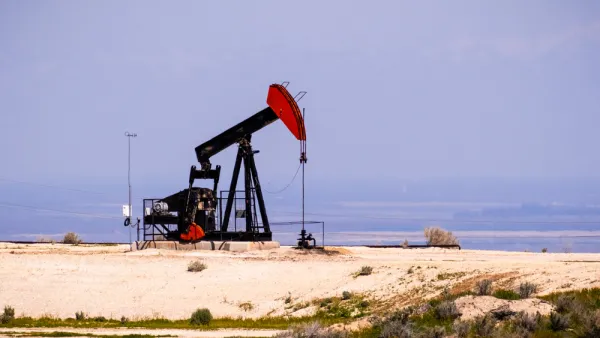Contrary to what would seem logical, estimates of oil and natural gas reserves may increase as they are depleted, as the new USGS assessment of recoverable oil reserves in the greater Bakken Basin shows. How does this square with peak oil theory?
The United States Geological Survey announced on April 30 that the recoverable oil reserves in the 'greater Bakken shale basin' area found within North Dakota, South Dakota and Montana [known as the the Williston Basin Province (PDF) had doubled, now estimated at 7.4 billion barrels, since their last estimate taken in 2008 (which was "25 times higher than its previous estimate made in 1995").
See a map of the three-state Williston Basin Province in the USGS fact sheet (PDF) on the report.
Kevin Bullis, MIT Technology Review's senior editor for energy, explains the seemingly illogical increasing oil reserves in the face of what could be viewed as oil companies rapidly depleting the nation's oil supply to feed our voracious appetite of 19 million barrels of oil a day.
- "Geologists understanding of oil-containing formations is incomplete" - hence the use of the word 'estimates'. Furthermore, has more drilling is done, "geologists learn more about the formation."
- The estimate considers more than the the actual amount of oil in the ground. It also takes into account "the amount of oil that can be recovered with existing technology", and technology has been rapidly increasing in the fields of hydraulic fracturing (fracking) and horizontal drilling.
- The price of oil is a huge determinant in how much oil that drillers will go after - with low prices, it may not be cost-effective to drill for it. Furthermore, higher prices spur new advancements in drilling technology.
As a result, "estimates of recoverable oil" are in fact a moving target.
You may be asking what the 'peak oil' subscribers have to say about the increasing reserves as they would seemingly defy their theory that we are 'running out of oil'. Brad Plumer of Washington Post's Wonkblog did just that in his April 13 interview with energy analyst Chris Nelder who argues that "(o)ur newfound oil resources aren’t nearly as promising as they first appear. And peak oil is still as relevant as ever."
Nelder maintains the peak oil theory by asserting that the "growth in conventional oil production ended in 2004, and we’ve been on a bumpy plateau ever since." Shale oil found in the Williston Basin, as well as the oil sands of Alberta, Canada and Venezuela are unconventional as opposed to conventional oil. [See the International Energy Agency's FAQ for concise descriptions of the two types of oil and the peak oil argument.]
If oil supplies are indeed increasing, as the USGS report would seemingly indicate, what does that mean for those fighting climate change?
Bullis first suggests that environmentalists "should stop hoping that we’ll run out. We won’t." The resource in North Dakota is dwarfed by the potential of kerogen oil, which is dwarfed by the amount of natural gas in methane hydrates...
"To reduce the use of fossil fuels, the focus should be on developing (viable) alternatives", he suggests at the end of his article.
A carbon pricing strategy would certainly increase the viability of competing, non-hydrocarbon alternatives as well.
FULL STORY: The Amount of Oil We Can Recover Keeps Growing

National Parks Layoffs Will Cause Communities to Lose Billions
Thousands of essential park workers were laid off this week, just before the busy spring break season.

Retro-silient?: America’s First “Eco-burb,” The Woodlands Turns 50
A master-planned community north of Houston offers lessons on green infrastructure and resilient design, but falls short of its founder’s lofty affordability and walkability goals.

Delivering for America Plan Will Downgrade Mail Service in at Least 49.5 Percent of Zip Codes
Republican and Democrat lawmakers criticize the plan for its disproportionate negative impact on rural communities.

Test News Post 1
This is a summary

Test News Headline 46
Test for the image on the front page.

Balancing Bombs and Butterflies: How the National Guard Protects a Rare Species
The National Guard at Fort Indiantown Gap uses GIS technology and land management strategies to balance military training with conservation efforts, ensuring the survival of the rare eastern regal fritillary butterfly.
Urban Design for Planners 1: Software Tools
This six-course series explores essential urban design concepts using open source software and equips planners with the tools they need to participate fully in the urban design process.
Planning for Universal Design
Learn the tools for implementing Universal Design in planning regulations.
EMC Planning Group, Inc.
Planetizen
Planetizen
Mpact (formerly Rail~Volution)
Great Falls Development Authority, Inc.
HUDs Office of Policy Development and Research
NYU Wagner Graduate School of Public Service





























